

RISQUES EMERGENTS. A propos de ces maladies vectorielles qui émergent en Europe : 4e réunion annuelle du projet Eden. Intégré au 6e PCRDT (Programme cadre de recherche et du développement technologique) de la Commission européenne, le projet Eden démarrait en 2004 sur une initiative du Cirad, de l'Ird et de l'Institut Pasteur de Paris pour une durée de cinq ans.
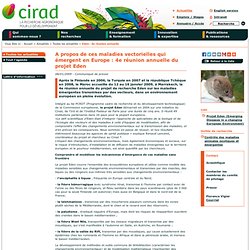
Il réunit 49 institutions partenaires dans 24 pays pour la plupart européens. Interdisciplinary Perspectives on Infectious Diseases Volume 2009 (2009), Effects of Climate Change on Ticks and Tick-Borne Diseases in Europe. Parasit Vectors. 2016; 9: 582. Ticks (Acari: Ixodidae) infesting cattle and some other domestic and wild hosts on the French Mediterranean island of Corsica. Tiques en France. Eurosurveillance, Volume 17, Issue 42, 18 October 2012 Tick-borne encephalitis joins the diseases under surveillance in the European Union. Tick-borne encephalitis joins the diseases under surveillance in the European Union Citation style for this article: Amato-Gauci AJ, Zeller H.

Tick-borne encephalitis joins the diseases under surveillance in the European Union. Euro Surveill. 2012;17(42):pii=20299. Available online: Date of submission: 17 October 2012 Climate and environmental changes are suspected as major determinants that alter the distribution and transmission patterns of certain communicable diseases, especially those transmitted by arthropods, such as ticks (e.g. tick-borne encephalitis (TBE) and Lyme disease), mosquitoes, (e.g. In the European Union (EU), climate and environmental changes are believed to be a cause for the recent resurgence of ‘old suspects’ such as malaria, as well as the geographic expansion of diseases like West Nile fever or TBE [4]. On 5 September 2012, TBE was included in the list of notifiable diseases in the EU.
References European Centre for Disease Prevention and Control (ECDC). FRONTIERS IN PUBLIC HEALTH 01/12/14 Ixodes ricinus and its transmitted pathogens in urban and peri-urban areas in Europe: new hazards and relevance for public health. Introduction Tick-borne infections are arthropod-borne diseases frequently reported worldwide.
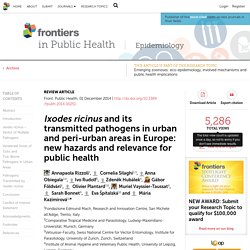
Ticks are known to transmit a great variety of pathogenic agents producing the highest number of human disease cases compared to other vector-borne diseases in Europe (1, 2). In general, the eco-epidemiology of zoonotic vector-borne diseases is very complex. It depends on the interactions of the vectors with the reservoir hosts and the pathogenic agents, which are modulated by several abiotic and biotic factors that vary in space and time. Certain tick-borne infections have recently been emerging in new regions or re-emerging within endemic sites and create an increasing concern for public health, food security, and biodiversity conservation (3–5). Urbanization as one of the socio-demographic factors has increased worldwide in recent decades (11, 12).
Urban areas are highly fragmented environments composed of a mosaic of patches of various sizes, vegetation, and land-use types. Figure 1. Birds. EUROSURVEILLANCE 29/09/11 Au sommaire: Tick-borne encephalitis in Europe, 2007 to 2009. Eurosurveillance, Volume 15, Issue 27, 08 July 2010 Au sommaire: Human activities predominate in determining changing incidence of tick-borne encephalitis in Europe. Explanations for the dynamics of tick-borne disease systems usually focus on changes in the transmission potential in natural enzootic cycles.
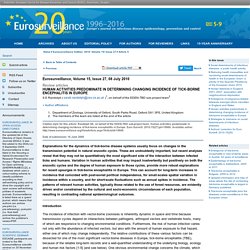
These are undoubtedly important, but recent analyses reveal that they may not be quantitatively the most significant side of the interaction between infected ticks and humans. Variation in human activities that may impact inadvertently but positively on both the enzootic cycles and the degree of human exposure to those cycles, provide more robust explanations for recent upsurges in tick-borne encephalitis in Europe. This can account for long-term increases in incidence that coincided with post-soviet political independence, for small-scales spatial variation in incidence within a country, and for short-scale fluctuations such as annual spikes in incidence.
Introduction Figure 1. No single factor is likely to cause such a pattern. Long-term impacts from political independence Small-scale impacts of land cover, land use and land tenure Figure 2. Vector-Borne Diseases in the UK – Biennial Conference 2014 - BugBitten. Victor Brugman (The Pirbright Institute) and Stacey Leech (Public Health England) This month saw a swarm of parasitologists, entomologists, virologists and ecologists descend on the University of Liverpool for the second conference on ‘Vector-Borne diseases (VBD) in the UK’.
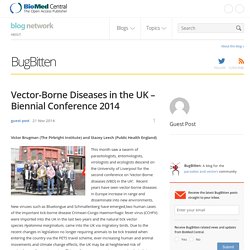
PARASITES & VECTORS - 2016 - Environmental factors influencing tick densities over seven years in a French suburban forest. Our 7-year longitudinal survey revealed fluctuating densities in populations of nymphs, but no changes in adult tick populations.

It is well known that abiotic factors, such as temperature and humidity, are key determinants in tick development, survival, and activity [27, 28, 29, 30, 31]. There were a number of associations between meteorological factors and variation in annual/monthly nymph density. First, minimum and not mean or maximum monthly temperatures were more strongly associated with nymph density. These results are consistent with the recognised temperature-dependent activity of I. ricinus in France, where activity occurs from ~7 °C, with an upper limit, which is influenced by epicuticle degradation that occurs at 32 °C and mortality at 40 °C, beyond that observed in our study (27.7 °C) [32]. The weak and opposing associations of I. ricinus densities with temperatures recorded 8 to 10 months earlier is intriguing, but must be treated with caution. PARASITES AND VECTORS 11/03/14 Prevalence of tick-borne encephalitis virus in Ixodes ricinus ticks in northern Europe with particular reference to Southern Sweden.
The common tick Ixodes ricinus is the most important arthropod vector of pathogens of human diseases in Europe [1, 2].
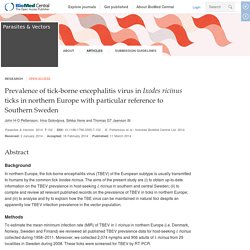
One of these pathogens potentially causing human disease is the tick-borne encephalitis virus (TBEV), a member of the tick-borne group within the genus Flavivirus[3], family Flaviviridae [4]. Tick-borne encephalitis (TBE) is a potentially fatal disease syndrome of humans and some other mammals [5]. TBE is endemic in central, eastern, and northern Europe eastwards through Russian Siberia and China [6, 7, 8]. During the last two decades, 1990–2009, an annual mean incidence of 2,815 cases of human TBE was recorded for Europe, while a corresponding annual mean incidence of 5,682 human TBE cases was reported from Russia [7]. EUROSURVEILLANCE 29/09/11 Au sommaire: Tick-borne encephalitis in Europe, 2007 to 2009. EFSA - 2012 - Systematic literature review on the occurrence of ticks and tick-borne pathogens in the EU and Mediterranean Basin. CDC EID - Volume 20, Number 10—October 2014. Au sommaire notamment: Prevalence of Borrelia miyamotoi in Ixodes Ticks in Europe and the United States.
THE LANCET 23/03/15 Effect of climate change on vector-borne disease risk in the UK. PARLEMENT EUROPEEN - Réponse à question E-5443/08 Les maladies vectorielles et le changement climatique. Les rapports les plus récents de l'Organisation mondiale de la santé(1) et le Centre européen pour la prévention et le contrôle des maladies(2) mettent en garde contre les effets du changement climatique sur les maladies vectorielles.
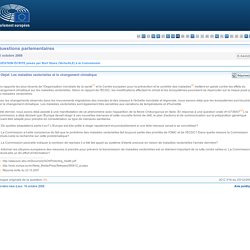
Selon le rapport de l'ECDC, les modifications affectant le climat et les écosystèmes pourraient se répercuter sur le risque posé par les maladies vectorielles. Avec les changements observés dans les mouvements migratoires des insectes et des oiseaux à l'échelle mondiale et régionale, nous savons déjà que les écosystèmes sont touchés par le changement climatique. Les maladies vectorielles sont également très sensibles aux variations de températures et d'humidité.
L'été dernier, nous avons déjà assisté à une manifestation de ce phénomène avec l'apparition de la fièvre Chikungunya en Italie. 1. 2. 3. 4.